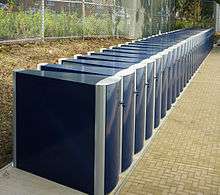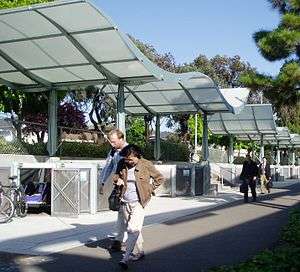Bicycle locker




A bicycle locker or bike box is a locker or box in which a single bicycle can be placed and locked in. They are usually provided at places where numerous cyclists need bike parking for extended times (such as during the working day or at university),[1] yet where the bikes might otherwise get damaged or stolen (such as at public bus terminals).
Bike boxes are considered the highest standard of bike safety (better than locked compounds or simple bike stands) because they prevent not only theft, but also casual vandalism.[2]
Shapes
Lockers are usually either rectangular boxes or formed as triangles where the handlebars of the bicycle are on the wide side of the triangle. Triangle wedged shaped lockers can also be combined to form a rectangular box with two individual lockers facing back to back. They can also be arranged in a circular pattern around a centre point or fanning out from a corner. Some lockers can also be installed in a straight line standing shoulder to shoulder. Some rarer types are either upright like school lockers (which requires the bicycle to be suspended from a hook inside) or are stacked twice high, with some attendant difficulties in inserting and removing bikes in the top row.
Bike Lockers are usually built with solid sides to protect against weather, vandalism and theft. However, problems encountered with this approach (such as being used by homeless people as sleepouts, or for the storage of things other than bicycles) have led to newer designs which incorporate windows or grilles through which inspection staff can see inside.
Locks
Bike box locks depend on whether the boxes are rented out on a fixed period basis, or whether they are first-come-first served. Those which are rented out for a set period of time usually come with a specific key. Those which are usable on a more casual basis either allow the door to be locked by a padlock brought along by the user, or provide a rental system that dispenses a key or code.[3]
Statistics from the BART rail system suggest that the effective capacity of an on-demand locker bank is 7- 10 times higher than a similar sized exclusive locker bank.

Automated lockers
Automated bicycle parking is becoming more common in Europe. These systems often store the bikes underground and usually function with users using a microchip card and a personal pin code to store and retrieve their bicycles.[4]
One mechanized system is the Bike Tree. When a user presents an access card, a motor lowers a hook from the top of the "tree". The front wheel of the cycle is attached to the hook, and a motor returns the hook to the top of the tree. The system was pioneered by Bicycle Tree International, headquartered in Geneva, Switzerland, a company which has however since ceased operations.[5] JFE Engineering in Japan produce a system called Cycle Tree; the installation at Kasai Station Bicycle Parking Lot in Tokyo has space for 6,480 bicycles, the largest underground mechanical bicycle parking system in the world. [6]
See also
References
- ↑ Riding Your Bike to Work or School - On-Campus Bike Lockers (from the University of Washington website. Accessed 2008-08-25.)
- ↑ Australian Standard AS 2890.3 – 1993 Parking Facilities Part 3: Bicycle Parking
- ↑ BART to install electronic bike lockers (from the Bay Area Rapid Transit website. Accessed 2008-08-25.)
- ↑ Smart cycle parking (from faircompanies.com. Accessed 2009-06-29.)
- ↑ Sherwood Stranieri (2008-07-10). "Bicycles Don't Fall Out of These Trees". Using Bicycles. Retrieved 2008-07-27.
- ↑ CYCLE TREE: Multi-level Mechanical Bicycle Parking System http://www.jfe-eng.co.jp/en/en_product/environment/environment2134.html